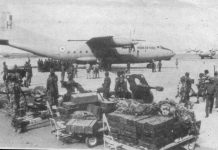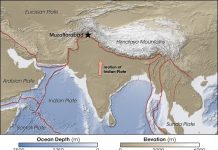It is a testimony to the secrecy maintained by RAW (Research and Analysis Wing) that there is so less concrete information available on the web about its operations. Sadly, this often portrays a sorry picture of RAW in the public domain. If you really want to know the fear that RAW invokes in the minds of enemies, you should checkout this article written by a Pakistani reporter. Anyways here are some of the known Top 10 Amazing RAW Operations.
Amalgamation of Sikkim

Bordered by Tibet, Nepal, Bhutan and West Bengal in the Eastern Himalayas, Sikkim was ruled right from Indian Independence by a Maharaja. The Indian Government had recognized the title of Chogyal (Dharma Raja) for the Maharaja of Sikkim. In 1972, RAW was authorized by Indira Gandhi to install a pro-Indian democratic government there. In less than three years, Sikkim became the 22nd State of the Indian Union, on April 26, 1975.
Operation Smiling Buddha

Operation Smiling Buddha was the name given to India’s nuclear Programme. The task to keep it under tight wraps for security was given to RAW. This was the first time that RAW was involved in a project inside India. On 18 May 1974, India detonated a 15-kiloton plutonium device at Pokhran and became a member of the nuclear club. All international intelligence agencies remained in dark about Indian nuclear weapons programs until then.
Special Operations

After successfully, separating Bangladesh from Pakistan, RAW tried to destabilize Pakistan and separate Baluchistan from it. In the mid 1980’s, RAW set up two covert groups, Counterintelligence Team-X (CIT-X) and Counterintelligence Team-J (CIT-J), the first directed at Pakistan and the second at Khalistani groups(funded by ISI to separate Punjab from India). Rabinder Singh, the RAW double agent who defected to the United States in 2004, helped run CIT-J in its early years. Both these covert groups used the services of cross-border traffickers to ferry weapons and funds across the border, much as their ISI counterparts were doing. According to former RAW official and noted security analyst B. Raman, the Indian counter-campaign yielded results. “The role of our cover action capability in putting an end to the ISI’s interference in Punjab”, he wrote in 2002, “by making such interference prohibitively costly is little known and understood.” These covert operations were discontinued during the tenure of IK Gujral and were never restarted. B Raman the former RAW cabinet secretary, such covert operations were successful in keeping a check on ISI and were “responsible for ending the Khalistani insurgency.” He also notes that a lack of such covert capabilities, since they were closed down in 1997, has left the country even more vulnerable than before and says that developing covert capabilities is the need of the hour.
Snatch operations with IB

In late 2009, investigative journal, The Week ran a cover story on one of India’s major clandestine operations that the R&AW ran with Intelligence Bureau to nab terrorists infiltrating India via Nepal and other neighboring countries. In order to bypass the lengthy extradition process, RAW conducts snatch operations to nab suspects from various foreign countries. The suspect is brought to India, interrogated and is usually produced before a court. With emergence of Nepal as a terror transit point, RAW and the IB (Intelligence Bureau) started closely monitoring the movement of suspected terrorists in Nepal. According to The Week in last decade there has been close to 400 successful snatch operations conducted by RAW and/or IB in Nepal, Bangladesh and other countries. Some famous snatch netted Bhupinder Singh Bhuda of the Khalistan Commando Force, Lashkar militant Tariq Mehmood, Sheikh Abdul Khwaja, one of the handlers of the 26/11 attacks, etc. Most of the suspects are kept at Tihar Jail.
Intelligence on 2008 Mumbai Attacks

About two to six months before 26/11 Mumbai attacks, R&AW had intercepted several telephone calls through SIGINT, which pointed at impending attacks on Mumbai Hotels by Pakistan based terrorists, however there was a coordination failure and no follow up action was taken. Few hours before the attacks, R&AW technician monitoring satellite transmissions picked up conversations between attackers and handlers, as the attackers were sailing toward Mumbai. The technician flagged the conversations as being suspicious and passed them on to his superiors. RAW believed that they were worrying and immediately alerted the office of the National Security Advisor. However the intelligence was ignored. Later, just after the terrorists had attacked Mumbai, RAW technicians started monitoring the six phones used by the terrorists and recorded conversations between the terrorists and their handlers. On January 15, 2010, in a successful snatch operation, RAW agents nabbed Sheikh Abdul Khwaja, one of the handlers of the 26/11 attacks, chief of HuJI India operations and a most wanted terror suspect in India, from Colombo, Sri Lanka and brought them over to Hyderabad, India for formal arrest.
Operation Leech

Surrounded by Arakans and dense forest, Myanmar because of its Military Dictatorship had always been a worrisome point for Indian intelligence. As the major player in the area, India has sought to promote democracy and install friendly governments in the region. To these ends, RAW cultivated Burmese rebel groups and pro-democracy coalitions, especially the Kachin Independence Army (KIA). India allowed the KIA to carry a limited trade in jade (ornamental stone) and precious stones using Indian Territory and even supplied them with weapons. It is further alleged that KIA chief Maran Brang Seng met the R&AW chief in Delhi twice. However, when the KIA became the main source of training and weapons for all northeastern Indian rebel groups, RAW initiated an operation, code named Operation Leech, to assassinate the leaders of RAW trained Burmese rebels to set an example to other groups. Six top rebel leaders, including military wing chief of National Unity Party of Arakans (NUPA), Khaing Raza, were shot dead and 34 Arakanese guerrillas were arrested and charged with gunrunning.
Operation Chanakya

Operation Chanakya was the RAW operation in the Kashmir to infiltrate various ISI-backed Kashmiri separatist groups and restore peace in the Kashmir valley. R&AW operatives infiltrated the area, collected military intelligence, and provided evidence about ISI’s involvement in training and funding Kashmiri separatist groups. RAW was successful not only in unearthing the links between the ISI and the separatist groups, but also in infiltrating and neutralizing the militancy in the Kashmir valley. RAW is also credited for creating a split in the Hizb-ul-Mujahideen. Operation Chanakya also marked the creation of pro-Indian groups in Kashmir like the Ikhwan-ul-Muslimeen, Muslim Mujahideen, etc. These counter-insurgencies consist of ex-militants and relatives of those slain in the conflict. Ikhwan-ul-Muslimeen leader Kokka Parrey was himself assassinated by separatists.
Sri Lanka

RAW started training, LTTE (Liberation Tigers of Tamil Eelam) to keep a check on Sri Lanka, which had helped Pakistan in the Indo-Pak War by allowing Pakistani ships to refuel at Sri Lankan ports. However, the LTTE created a lot of problems and complications and the then Prime Minister of India Rajiv Gandhi was forced to send the Indian Peace Keeping Force (IPKF) in 1987 to restore normalcy in the region. The disastrous mission of the IPKF was blamed by many on the lack of coordination between the IPKF and RAW. Its most disastrous manifestation was the Helicopter assault on LTTE HQ in the Jaffna University campus in the opening stages of Operation Pawan. The site was chosen without any prior consultation with the RAW. The dropping paratroopers became easy targets for the LTTE. A number of soldiers were killed. The assassination of Rajiv Gandhi is also blamed as fallout of the failed RAW operation in Sri Lanka.
Creation of Bangladesh and Aftermath

In the early 1970s, the army of Pakistan prosecuted a bloody military crackdown in response to the Bangladeshi independence movement. Nearly 10 million refugees fled to India. The R&AW’s Bangladeshi independence movement began in early 1970 by sowing discord among the disgruntled population of Bangladesh (then called East Pakistan), suffering repression by the Pakistani political establishment. This led to the creation of the Mukti Bahini (Liberation Army of Bengali resistance movement). RAW was responsible for supplying information and heavy ammunition to this organization that led to Bangladesh War, its independence and later self-governance within months. Even USA hasn’t been successful at achieving this in Afghanistan and Iraq. However, within months of independence of Bangladesh, Mujibur Rahman (First President) was assassinated at his residence. R&AW operatives claim that they had advance information about Mujib-ur-Rahman’s assassination, but he tragically ignored R&AW’s inputs. He was killed along with 40 members of his family. R&AW thus failed to prevent the assassination, which led to the loss of a charismatic leader who had a soft corner for India after all they had done for his country’s independence. However, R&AW has successfully thwarted plans of assassinating Sheikh Hasina Wazed, daughter of Mujibur Rahman, by Islamist extremists and the ISI.
Operation Kahuta

Operation Kahuta is regarded by many as one of the most daring operation ever conducted by RAW. The only reason it failed was due to a grave blunder by an Indian Prime Minister. Kahuta is the site of the Khan Research Laboratories (KRL), Pakistan’s main nuclear weapons laboratory as well as an emerging center for long-range missile development. The primary Pakistani fissile-material production facility is located at Kahuta, employing gas centrifuge enrichment technology to produce Highly Enriched Uranium (necessary for nuclear weapons). RAW first confirmed Pakistan’s nuclear programs by analyzing the hair samples of scientists snatched from the floor of barber shops near KRL; which showed that Pakistan had developed the ability to enrich uranium to weapons-grade quality. R&AW agents knew of Kahuta Research Laboratories from at least early 1978, when the then Indian Prime Minister, Morarji Desai stopped RAWs operations on Pakistan’s covert nuclear weapons program (because it was started by Indira Gandhi). In an indiscreet moment in a telephone conversation one day, Morarji Desai informed the then Pakistan President, Zia-ul-Haq, that India was aware of Pakistan’s nuclear weapons program. According to later reports, acting on this “tip-off”, Pakistani Intelligence eliminated RAW’s agents on Kahuta, leaving India in the dark about Pakistan’s nuclear weapons program from then on.
If you really want to know the fear that RAW invokes in the minds of enemies, you should check out this insightful article written by a Pakistani reporter.
































